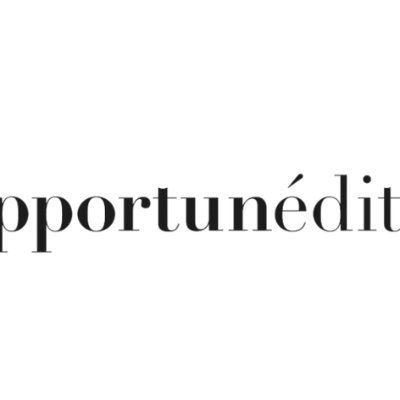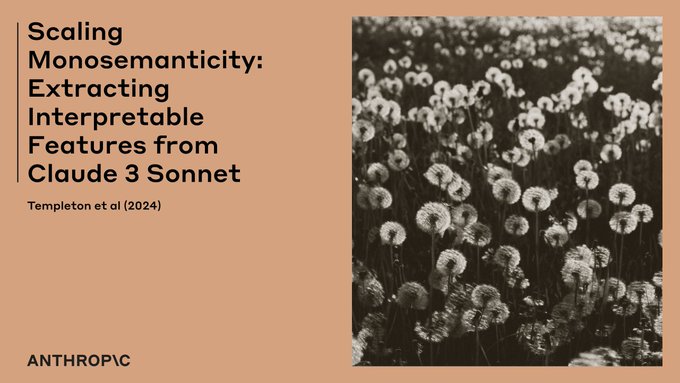
Jack Lindsey
@Jack_W_Lindsey
Followers
1,398
Following
213
Media
45
Statuses
202
Interested in understanding neural networks (all kinds!) -- @AnthropicAI . Previously @cu_neurotheory .
Joined January 2019
Don't wanna be here?
Send us removal request.
Explore trending content on Musk Viewer
Texas
• 232821 Tweets
Michigan
• 196427 Tweets
Mustafa Kemal
• 145044 Tweets
Notre Dame
• 94831 Tweets
#precure
• 46229 Tweets
Iowa
• 32721 Tweets
Northern Illinois
• 29019 Tweets
Sabalenka
• 28706 Tweets
#AEWAllOut
• 21927 Tweets
Auburn
• 21336 Tweets
Nebraska
• 20747 Tweets
#仮面ライダーガヴ
• 17220 Tweets
T-岡田
• 15481 Tweets
South Bend
• 13534 Tweets
#nitiasa
• 13308 Tweets
#ボクらの時代
• 11364 Tweets
Huskies
• 10967 Tweets
Last Seen Profiles
Pinned Tweet
Recently at
@CogCompNeuro
I led a tutorial on sparse autoencoders for LLM interpretability. For anyone interested, here's the link!
0
45
340
What kinds of representations do neural networks learn? In this paper w/
@allemanjm
and
@StefanoFusi2
, to appear at
#ICLR2024
, we find & explain effects of task structure and choice of nonlinearity on learned representational geometry . Thread:
2
39
213
Excited to share the capstone work of my PhD, w/
@vulcnethologist
@Datta_Lab
and Ashok Litwin-Kumar. We think it’s an exciting step in understanding how the brain implements reinforcement learning, at a neuronal and algorithmic level.
3
27
130
Really excited about this work from our team! Personally, I am amazed by some of the findings. The kinds of abstractions you can find represented inside this model are quite deep, and often surprising. I expect this is just the beginning for large-scale interpretability!
4
12
126
What makes convolutional neural networks brain-like? We’ve identified new properties besides classification performance, like factorization of scene parameters, that predict resemblance to visual cortex data. Check out our
#COSYNE2021
poster 1-048 (w/ Elias Issa) on Wednesday!
1
5
56
Check out our poster (I-031) tomorrow
@CosyneMeeting
!
"Cortical dopamine enables deep reinforcement learning and leverages dopaminergic heterogeneity"
We propose a role for dopamine in representation learning in RL. Would love to discuss with anyone interested!
#COSYNE2023
1
4
31
Part 2 of our work (led by Kevin) on the role of motor cortex + basal ganglia in "flexible" vs. "automatic" tasks! Esp. excited about a phenomenon (which we model!) where subcortical consolidation of automatic behaviors is prevented by simultaneously practicing flexible behaviors
0
3
22
Excited to give a talk tomorrow at
#ICLR2019
on using convolutional neural networks to understand animal visual processing! Title: A Unified Theory of Early Visual Representations from Retina to Cortex through Anatomically Constrained Deep CNNs. Link:
1
3
21
For anyone at
@CosyneMeeting
, I'm presenting new work on how RL in the basal ganglia Friday (02-087). I'm excited about this work, which clarifies some puzzling empirical findings and suggests a new understanding of the learning algorithm used by the BG. Tweetprint coming soon!
0
2
19
A paper I contributed to in undergrad, exploring modular error-correcting dynamics in mouse ALM, is now out! Congrats to lead authors Guang Chen and Byungwoo Kang, and PIs Nuo Li and Shaul Druckmann (
@ShaulDr
).
My favorite parts are (1/2)
2
3
16
Check out our new work on the theory of multi-task learning and pretraining+finetuning!
What are the consequences of training networks on multiple tasks?
@Jack_W_Lindsey
and I give a theoretical description of the biases of pretraining + finetuning and multi-task learning. There are surprising findings with practical implications! (1/15)
2
25
90
0
0
15
This work builds a lot on ideas and methods from
@KhurramJaved_96
+ Martha White,
@jeffclune
,
@thomasmiconi
,
@chelseafinn
. And might be interesting to others recently working on bio-plausible credit assignment, including
@tyrell_turing
,
@kordinglab
,
@NeuroAILab
. [Bonus/14]
1
2
13
I'll be presenting this work at NeurIPS tomorrow (Tuesday) at virtual poster session 2, 12 - 2pm. Stop by if you're interested or have questions!
Paper:
GitHub:
0
2
12
Upcoming ICLR paper!
Why are receptive fields circular in the retina but sharply oriented in primary visual cortex (V1)? Answers in our new
#ICLR2019
paper using a deep convolutional model of the visual system: . With
@Jack_W_Lindsey
,
@SamOcko
and
@SuryaGanguli
.
⬇ THREAD ⬇
8
94
266
0
2
9
New work led by
@KevinMizes
on the role of striatum in flexible vs. automatic movements!
Thrilled to share my graduate work with PI
@BOlveczky
and co-authors
@Jack_W_Lindsey
&
@seanescola
: 'piano playing' rats!
tl;dr - striatum is needed to produce automatic but not flexible sequences, but it codes for & controls low-level kinematics for both
5
40
157
0
2
9
and
@_Nils_Otto_
, Lisa Marin,
@gsxej
,
@ScottishWaddell
, and many other wonderful collaborators for being great to work with + getting me up to speed (at least a little) on fly neuroscience, and of course
@janeliaflyEM
for this awesome data. (22/22)
0
0
6
Thanks to my advisor Ashok Litwin-Kumar for his many contributions and guidance throughout this project, and for his patience as we cycled through crazy ideas
#1
through #(N-1) before arriving at this one :). (13/13)
1
0
6
Highlight
#1
: PN->KC connectivity has previously been modeled as random, an organization which (via expansion of representation dimensionality) supports discrimination between many sensory stimuli. The data, however, reveals significant deviations from randomness… (7/22)
1
0
5
@ericjang11
@StephaneDeny
@niru_m
My guess is that some additional bells and whistles in the optimization, a move to gradient-free (e.g. evolutionary) approaches, and/or some kind of curriculum learning during meta-training will be necessary. But I think / hope these are solvable problems!
1
0
5
@RobertRosenba14
@KordingLab
for learning that takes place over long timescales (e.g. storing memories for later use) that path you take in parameter space may look nothing like gradient descent, even if the loss decreases by the end -- and the "non-gradient" components may be essential for final performance
0
0
4
Our work presented at
#cosyne19
on understanding properties of early stage visual processing
Two
#cosyne19
posters elucidating early visual system hallmark properties, w/
@SamOcko
@Jack_W_Lindsey
&
@SuryaGanguli
:
1) Why are receptive fields concentric in the retina and oriented in primary visual cortex? We address this question with an anatomically constrained deep CNN.
1
10
38
0
1
4
@KordingLab
@itamarlandau
@TonyZador
@tyrell_turing
@PessoaBrain
@KordingLab
Potential concerns (also sorry if jumping in randomly violates Twitter etiquette!): E[perturb + select] only equals gradient if (1) perturbations are sufficiently small rel. to curvature of loss landscape, and (2) "select" happens fast enough rel. to "perturb"...
2
0
4
Highlight
#4
: DANs receive extensive modulation from MBONs, both direct and multisynaptic, within and across compartments. Broadly, this suggests a “critic” role for MBONs in contributing to learning signals, beyond their classical “actor” role in driving behaviors. (14/22)
1
0
3
@ericjang11
@StephaneDeny
@niru_m
This is a great post! I very much agree with the approach described. But I do think executing on this idea may not be so straightforward to do at scale. Backprop (naively implemented) doesn't seem great at handling long-horizon meta-learning problems.
1
0
3
See our recent NeurIPS paper!
1/ Why are there so many *types* of ganglion cells transmitting visual information from the retina to the brain? In this joint work with
@SamOcko
, Jack Lindsey and
@SuryaGanguli
, we tried to answer this question through the lens of efficient coding:
1
28
77
0
0
2
@Neuro_Skeptic
I think the burgeoning field of mechanistic interpretability of LLMs / other deep learning models (which I now work in!) is a relevant case study (caveat: of course these models are different than brains). It's hard but there has been a lot of progress in recent years!
0
0
3
@blake_camp_1
@KordingLab
@tyrell_turing
@TonyZador
@neuro_data
@bradpwyble
You might find this review interesting:
(Though the cell-intrinsic parameters it focuses on might be different from those you have in mind)
1
0
3
@tyrell_turing
@blake_camp_1
@risi1979
@enasmel
@neurograce
@TonyZador
@kenneth0stanley
@jeffclune
@asoltoggio
@ThomasMiconi
@KordingLab
@NeuroAILab
@hardmaru
In the spirit of "networks do what they are trained to do," I feel like meta-learning for "general purpose" learning -- where task distribution is vast + diverse -- is basically unexplored (to my knowledge) and it's hard to say whether it can work or not.
4
0
3
@RobertRosenba14
@KordingLab
Thanks for the shout out! Yeah I support maintaining a bit of gradient skepticism :). Even in a single-objective setting, the only requirement is that the loss function needs to decrease. If the loss is very bumpy, good parameter updates may be unrelated to gradients. And…
1
0
3
@blake_camp_1
@tyrell_turing
@risi1979
@enasmel
@neurograce
@TonyZador
@kenneth0stanley
@jeffclune
@asoltoggio
@ThomasMiconi
@KordingLab
@NeuroAILab
@hardmaru
Yeah could be. Hard to say without making a serious effort though.
@niru_m
and
@Luke_Metz
seem to have made some progress on making these kinds of problems more tractable (). Obviously not closed to a solved problem though
0
0
3
@KordingLab
@itamarlandau
@TonyZador
@tyrell_turing
@PessoaBrain
(If
#2
isn’t satisfied then effective step size is larger, cf.
#1
). Also even if expectations are equal, expected update can be a poor approx. of an optimizer’s actual behavior given finite step size (see e.g. SGD vs. GD). Is there empirical reason not to worry about these?
1
0
2
Many thanks to my awesome collaborators and my thesis committee -- Larry Abbott,
@neuro_kim
,
@VikramGadagkar
, and
@naoshigeuchida
-- for their many helpful comments and suggestions.
0
0
2
@TheGregYang
This is awesome! Two questions if you know: (1) how does the GP for vanilla RNNs, T time steps, input only at first time step, differ from that of depth-T MLP? (2) Can you still get GP behavior if weights are sparse? (e.g. w~Gaussian w.p. eps=k/N, else 0, k fixed as N->infinity)
1
0
2
@tyrell_turing
Yeah I agree. I think the dream would be a mechanism that is general-purpose when necessary but can also take shortcuts. Probably requires more ingredients than just fixed feedback + Hebbian learning. Maybe (wild speculation) even an extra level of "meta"...
1
0
2
































































